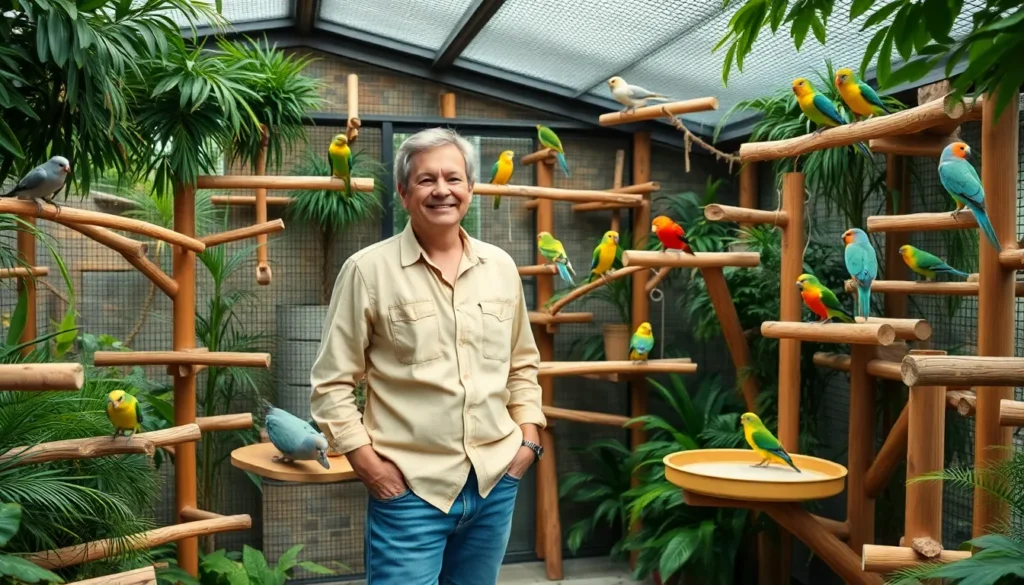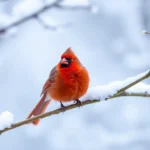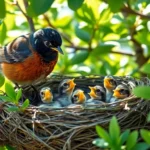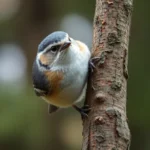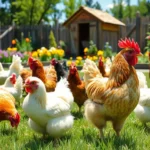We’ve all watched our feathered friends soar freely through the sky and wondered how we can provide them with the perfect home that mirrors their natural habitat. Creating the ideal bird enclosure isn’t just about choosing any cage – it’s about understanding our birds’ unique needs and designing a space where they’ll truly thrive.
Whether we’re housing a single canary or a flock of parrots our enclosure decisions directly impact their physical health mental stimulation and overall happiness. The right setup can transform a simple living space into an enriching environment that promotes natural behaviors and keeps our birds engaged for hours.
From sizing considerations to material choices and safety features we’ll guide you through everything needed to create an enclosure that both you and your birds will love. Let’s explore how to build the perfect sanctuary that balances freedom security and comfort.
Choose the Right Size Bird Enclosure for Your Feathered Friend
Selecting the proper dimensions forms the foundation of any successful bird enclosure setup. We’ll walk you through the essential calculations and considerations that ensure your birds have adequate space to thrive.
Calculate Minimum Space Requirements
Start with wingspan measurements to determine the absolute minimum enclosure dimensions your bird needs. Most avian specialists recommend cages that allow birds to fully extend their wings without touching the sides, which means measuring your bird’s wingspan and adding at least 6-8 inches on each side.
Use the “three times rule” for basic sizing calculations where the enclosure width should be at least three times your bird’s wingspan. Smaller birds like canaries need minimum dimensions of 24 inches wide by 16 inches deep, while larger parrots require spaces measuring 48 inches wide by 36 inches deep or more.
Factor in perch placement when calculating usable space since perches reduce the available flight area significantly. We recommend leaving at least 18 inches of clear horizontal space between perches for most medium sized birds, with larger species needing 24-30 inches of unobstructed flying room.
| Bird Type | Minimum Width | Minimum Depth | Minimum Height |
|---|---|---|---|
| Finches/Canaries | 24 inches | 16 inches | 18 inches |
| Budgies/Cockatiels | 32 inches | 20 inches | 24 inches |
| Small Parrots | 40 inches | 30 inches | 32 inches |
| Large Parrots | 48+ inches | 36+ inches | 40+ inches |
Consider Flight Patterns and Wing Span
Observe natural flight behaviors to understand how your exact bird species moves through space. Horizontal fliers like finches need wider enclosures rather than tall ones, while vertical climbers such as cockatiels benefit from additional height for their natural climbing and short hopping movements.
Measure wing span accurately by gently extending your bird’s wing to its full length and adding the body width for total span calculations. Active fliers require enclosures that are 4-5 times their wingspan width, while less active species can manage with 3 times their wingspan measurement.
Account for landing space since birds need adequate room to slow down and perch safely after flight. We suggest maintaining at least 12 inches of clear space around primary perching areas, with emergency landing spots positioned throughout the enclosure for sudden direction changes.
Account for Multiple Birds
Calculate space per bird using the base requirements and adding 50% additional space for each additional bird in the enclosure. Two budgies need approximately 48 inches of width instead of the 32 inches required for a single bird, ensuring each has adequate territory and flight paths.
Plan for social hierarchies by creating multiple feeding stations and perching levels to prevent dominant birds from monopolizing resources. We recommend spacing food and water sources at least 18 inches apart in different areas of the enclosure to reduce competition and stress.
Design escape routes throughout the enclosure so subordinate birds can avoid conflicts and find safe spaces. Multiple entry and exit points between different sections allow birds to move freely without feeling trapped, which is especially important in mixed species setups or breeding situations.
Select Appropriate Materials for Your Bird Enclosure
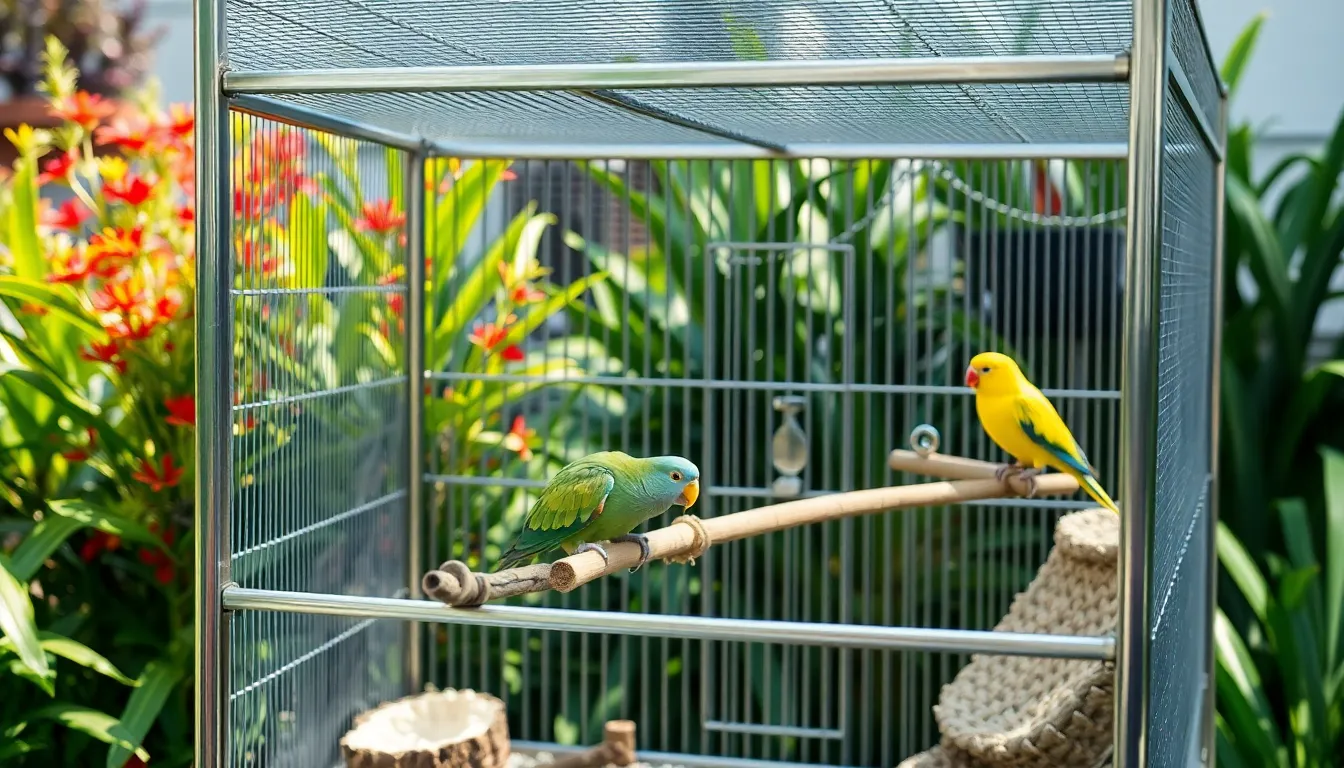
Material selection forms the foundation of a safe bird enclosure that protects your feathered companions from toxic exposure. We must prioritize materials that withstand daily use while maintaining the health standards our birds deserve.
Opt for Safe, Non-Toxic Metals
Stainless steel ranks as the premium choice for bird enclosure construction due to its non-reactive properties and durability. We recommend 304 or 316 grade stainless steel for maximum safety, as these grades contain no harmful additives that could leach into your bird’s environment.
Powder coated steel offers an excellent alternative when properly manufactured with bird safe coatings. These finishes create a smooth, easy to clean surface that resists chipping and scratching better than traditional paint options.
Wrought iron provides structural strength for larger enclosures but requires careful inspection for lead content. We suggest testing older wrought iron materials with lead detection kits before installation, as vintage pieces may contain dangerous levels of this toxic metal.
Avoid Harmful Coatings and Finishes
Zinc coated materials pose serious health risks to birds through zinc toxicosis, which can occur from prolonged exposure or ingestion. We must reject galvanized wire, bolts, and hardware that contain zinc coating, even when labeled as “safe” by general pet standards.
Lead based paints and primers remain extremely dangerous for birds, even in small quantities that might seem insignificant. Our birds’ sensitive respiratory systems and tendency to chew on cage materials make any lead exposure potentially fatal.
Chrome plating contains hexavalent chromium compounds that can cause respiratory irritation and other health issues in birds. We avoid chrome plated accessories and hardware, opting instead for solid stainless steel alternatives that provide similar aesthetic appeal without the health risks.
Choose Rust-Resistant Options
Marine grade stainless steel excels in humid environments and outdoor installations where moisture exposure increases corrosion risk. We select 316 grade stainless steel for coastal locations or areas with high humidity levels, as this grade contains molybdenum for enhanced corrosion resistance.
Aluminum construction offers lightweight durability for portable or temporary bird enclosures, though we must ensure proper alloy selection. Food grade aluminum alloys like 5052 or 6061 provide excellent corrosion resistance without introducing harmful additives that could affect bird health.
Powder coating thickness should measure between 2 to 4 mils for optimal protection against rust and wear. We verify coating specifications with manufacturers to ensure adequate coverage that won’t chip or flake under normal bird activity, maintaining both appearance and safety over time.
Design Your Bird Enclosure Layout for Maximum Comfort

Strategic layout design transforms your bird enclosure into a comfortable habitat that mirrors natural environments. We’ll explore how thoughtful placement of essential elements creates zones that support your birds’ daily routines and behavioral needs.
Position Perches at Varying Heights
Perch placement at different elevations mimics natural tree structures that birds navigate in the wild. We recommend positioning the highest perch approximately 75% of the enclosure’s total height to give dominant birds their preferred roosting spots. Lower perches should sit at 25% and 50% height levels to create a natural hierarchy system.
Natural wood branches work better than uniform dowels because they provide varying diameters that exercise your birds’ feet muscles. We suggest using apple, willow, or birch branches with diameters ranging from 0.5 to 2 inches depending on your bird species. Different thicknesses prevent foot problems and arthritis that develop from gripping identical surfaces.
Strategic spacing between perches allows comfortable flight paths without overcrowding the enclosure space. We maintain 18 to 24 inches of horizontal distance between perches for medium sized birds like cockatiels and conures. Larger parrots need 30 to 36 inches of clearance to spread their wings fully during movement.
Create Designated Feeding Areas
Feeding stations work best when positioned away from perches to prevent contamination from droppings and maintain food hygiene. We place food bowls at middle height levels where birds feel secure but can access meals without territorial disputes. Corner locations reduce competition stress among multiple birds sharing the same enclosure.
Separate water sources from food bowls by at least 12 inches to keep drinking water clean throughout the day. We install water dispensers at slightly lower heights than food bowls since birds naturally drink from ground level sources in their natural habitats. Stainless steel or ceramic bowls resist bacteria growth better than plastic alternatives.
Multiple feeding stations reduce aggressive behavior when housing several birds together in larger enclosures. We recommend one feeding area per bird plus one extra to ensure subordinate birds access food without confrontation. Fresh food holders should hang on opposite sides of the enclosure from seed dispensers to encourage natural foraging movements.
Include Private Nesting Spaces
Nesting boxes provide essential privacy that reduces stress hormones and allows birds to exhibit natural roosting behaviors. We position nesting areas in the upper third of the enclosure where birds feel most secure from ground predators. Dark, enclosed spaces trigger natural comfort responses that promote better sleep cycles.
Entrance holes sized appropriately for each species prevent larger birds from invading smaller birds’ nesting territories. We drill entrance holes 2.5 inches in diameter for cockatiels and 3.5 inches for larger conures and small parrots. Proper sizing ensures birds feel secure while maintaining easy access for cleaning and inspection.
Natural nesting materials encourage breeding behaviors even in non breeding birds by satisfying their instinctual needs. We provide coconut fiber, paper strips, and safe wood shavings that birds can arrange according to their preferences. Multiple nesting options give paired birds choices and single birds comfortable retreat spaces during stressful situations.
Install Essential Features in Your Bird Enclosure
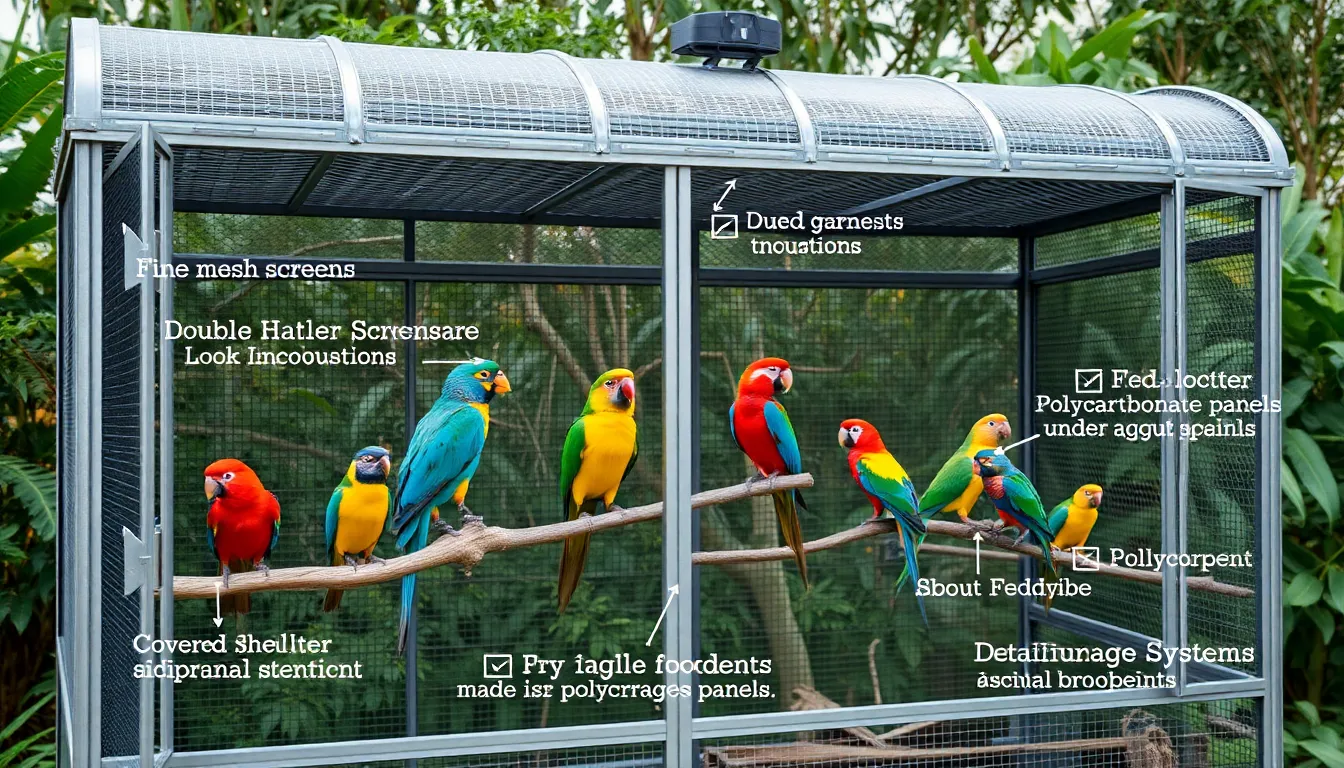
Beyond materials and layout design, we need to focus on three critical systems that ensure our birds’ safety and comfort year-round.
Add Proper Ventilation Systems
Maintaining fresh air circulation prevents respiratory issues and controls humidity levels in bird enclosures. We recommend installing cross-ventilation systems that create gentle airflow without creating drafts that could harm our feathered friends.
Position ventilation openings on opposite walls to encourage natural air movement through the enclosure. Adjustable vents work best because they allow us to control airflow based on seasonal weather changes and our birds’ exact needs.
Install fine mesh screens over all ventilation openings to prevent insects and small predators from entering while maintaining optimal air circulation. Stainless steel mesh provides the most durable protection against wear and corrosion.
Consider mechanical ventilation systems for larger enclosures or indoor setups where natural airflow isn’t sufficient. Quiet exhaust fans can remove stale air and excess moisture without disturbing our birds’ daily routines.
Include Weather Protection Elements
Shelter areas protect birds from rain, snow, wind, and excessive sunlight throughout all seasons. We should create covered sections that occupy at least one-third of the total enclosure space to give our birds adequate protection options.
Solid roofing materials like polycarbonate panels or marine-grade plywood provide excellent weather resistance while allowing natural light to filter through translucent sections. These materials withstand UV exposure and temperature fluctuations better than traditional plastic covers.
Add windbreaks along the sides of outdoor enclosures to reduce cold drafts during winter months. Natural barriers like bamboo screens or synthetic materials designed for outdoor use create comfortable microclimates within the space.
Install drainage systems to prevent water accumulation during heavy rainfall. Sloped flooring and drainage channels direct water away from feeding and resting areas where our birds spend most of their time.
Install Secure Locking Mechanisms
Double-latch systems prevent escape attempts and protect against unauthorized access to bird enclosures. We recommend using spring-loaded latches combined with secondary security features like padlocks or carabiner clips.
Choose locking mechanisms that require two separate actions to open, making it nearly impossible for clever birds to accidentally release themselves. Parrots and other intelligent species often learn to manipulate simple single-action latches.
Position locks high enough that children cannot reach them easily while still allowing adult caregivers convenient access for daily maintenance tasks. Mounting locks at chest height typically provides the best balance of security and accessibility.
Test all locking mechanisms weekly to ensure they haven’t become loose or damaged from weather exposure. Stainless steel hardware resists corrosion and maintains smooth operation even in harsh outdoor conditions.
Maintain Optimal Temperature Control in Your Bird Enclosure
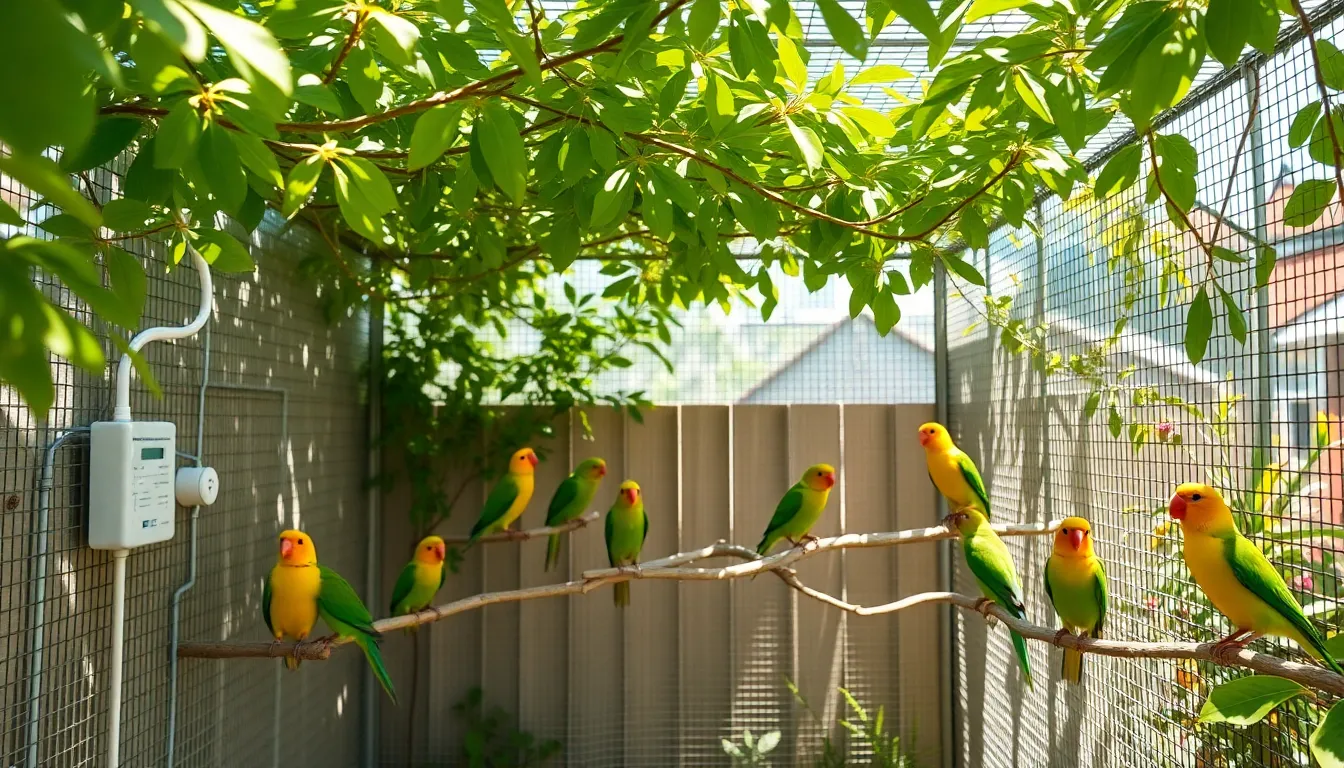
Temperature regulation proves crucial for maintaining bird health and comfort throughout the year. We’ll explore effective strategies to create a climate-controlled environment that supports your birds’ well-being.
Monitor Seasonal Temperature Changes
Track daily temperature fluctuations using digital thermometers placed at different heights within your bird enclosure. Most pet birds thrive in temperatures between 65°F and 78°F, with tropical species like macaws preferring the higher end of this range. Position multiple thermometers throughout the enclosure to identify hot and cold spots that might stress your birds.
Record temperature patterns during seasonal transitions to anticipate when heating or cooling interventions become necessary. Spring and fall present the most challenging periods as outdoor temperatures can swing dramatically within 24-hour cycles. We recommend checking temperatures twice daily during these seasons to ensure your birds aren’t exposed to sudden temperature drops that could compromise their immune systems.
Install automatic monitoring systems for enclosures housing multiple birds or valuable breeding pairs. Smart thermostats with smartphone alerts notify you immediately when temperatures fall outside safe ranges. These systems prove especially valuable for outdoor aviaries where weather conditions change rapidly and require immediate attention.
Provide Heating Answers for Cold Weather
Ceramic heat emitters offer the most reliable heating option for bird enclosures because they produce heat without visible light that might disrupt natural sleep cycles. Position these units 18 to 24 inches above perching areas to create warm zones without overheating exact spots. We recommend using thermostatic controls to maintain consistent temperatures between 70°F and 75°F during winter months.
Heated perches provide targeted warmth directly to your birds’ feet and bodies during cold weather. Choose perches with adjustable temperature settings that range from 102°F to 106°F to match birds’ natural body temperature. Ensure heated perches have chew-resistant cords and automatic shut-off features to prevent overheating injuries.
Install windbreaks around outdoor enclosures to reduce wind chill effects that can make temperatures feel significantly colder than actual readings. Clear polycarbonate panels work excellently as they block wind while maintaining visibility and natural light transmission. Position these barriers on the north and west sides of enclosures where cold winds typically originate during winter storms.
Ensure Adequate Shade for Hot Days
Create multiple shade zones using natural canopy coverage from trees or artificial shade cloth with 50% to 70% UV protection ratings. Position shade structures to cover at least 75% of the enclosure during peak sun hours between 10 AM and 4 PM. We’ve found that layered shade systems work best, combining overhead coverage with side panels that block afternoon sun.
Install misting systems to provide evaporative cooling during extremely hot weather when temperatures exceed 85°F. Fine mist nozzles create a cooling effect without soaking birds or creating muddy ground conditions. Set timers to activate misting systems for 5-minute intervals every hour during the hottest parts of summer days.
Provide cooling stations with shallow water dishes and ceramic tiles that stay cool even in direct sunlight. Position these cooling areas in the shadiest sections of your enclosure where birds can retreat when temperatures become uncomfortable. Natural stone surfaces like granite or slate work exceptionally well as they absorb less heat than metal or plastic alternatives.
Create an Enriching Environment Within Your Bird Enclosure
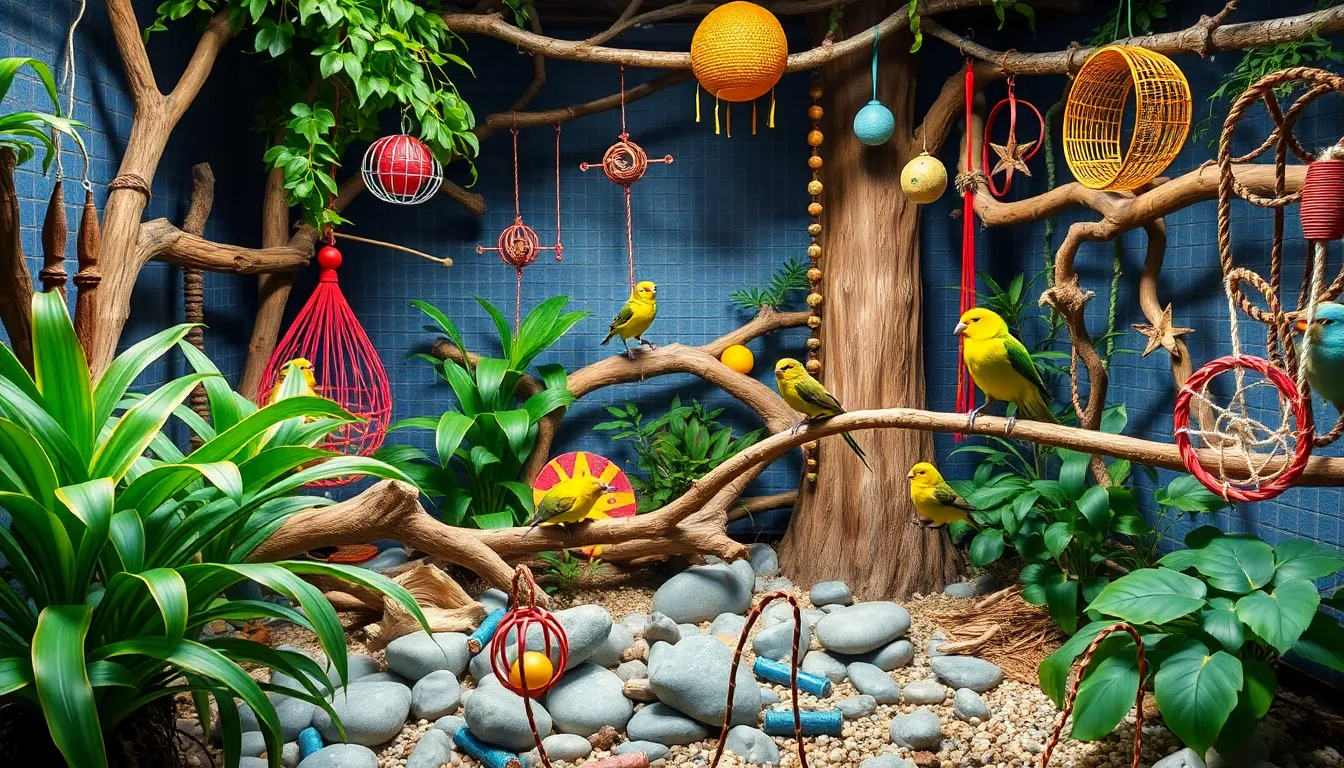
Creating a stimulating environment transforms a basic enclosure into a thriving habitat that promotes natural behaviors and mental well-being. We’ll focus on elements that enhance your birds’ quality of life while supporting their physical and psychological health.
Incorporate Natural Elements and Plants
Live plants serve as the foundation for recreating your birds’ natural habitat within their enclosure. We recommend spider plants, Boston ferns, and African violets as safe options that provide both visual appeal and foraging opportunities. These plants create natural perching spots while improving air quality through oxygen production.
Natural branches from bird-safe trees like apple, willow, or birch offer varying diameters that exercise your birds’ feet muscles. We suggest collecting branches from pesticide-free areas and thoroughly cleaning them before installation. Different branch thicknesses ranging from pencil-thin to 2 inches in diameter accommodate various grip preferences and prevent foot problems.
Organic substrates like coconut fiber, shredded paper, or natural wood shavings create comfortable ground cover that encourages natural foraging behaviors. We avoid cedar or pine shavings due to their aromatic oils that can irritate birds’ respiratory systems. Instead, aspen shavings provide a safe alternative that absorbs moisture effectively.
Rock formations and smooth river stones add texture variety while creating natural perching surfaces. We position larger stones as basking spots where birds can regulate their body temperature. Smaller pebbles scattered on the enclosure floor encourage ground foraging behaviors similar to those in wild environments.
Add Interactive Toys and Accessories
Foraging toys challenge your birds’ problem-solving abilities while satisfying their natural instinct to search for food. We recommend puzzle feeders, treat-dispensing balls, and hide-and-seek toys that require manipulation to access rewards. Rotating these toys weekly prevents boredom and maintains engagement levels.
Climbing structures like rope ladders, spiral perches, and natural wood gyms provide physical exercise opportunities. We install these accessories at various heights to create vertical exploration paths throughout the enclosure. Sisal rope and natural hemp materials offer safe textures that won’t harm your birds’ feet or beaks.
Mirror alternatives such as stainless steel bells, colorful wooden blocks, and textured chew toys satisfy curiosity without encouraging obsessive behaviors. We avoid traditional mirrors that can lead to hormonal issues in some bird species. Instead, reflective water dishes provide safe glimpses of their surroundings.
Swinging perches and hanging toys add movement elements that strengthen your birds’ balance and coordination. We secure these accessories with stainless steel hardware to ensure safety during active play sessions. Motion-activated toys that respond to your birds’ movements create captivating interactive experiences.
Provide Mental Stimulation Activities
Food presentation variety keeps mealtimes interesting by offering different textures, colors, and challenges throughout the week. We suggest wrapping treats in paper, hiding seeds in cardboard tubes, or freezing fruits in ice cubes during hot weather. These techniques transform routine feeding into captivating activities that occupy your birds for extended periods.
Training sessions using positive reinforcement create bonding opportunities while exercising your birds’ cognitive abilities. We recommend starting with simple commands like step-up and gradually progressing to more complex tricks. Target training using colorful sticks helps establish communication pathways between you and your birds.
Environmental changes through rearranging perches, introducing new textures, or altering lighting schedules prevent habituation and maintain curiosity. We make these modifications gradually to avoid stress while ensuring your birds remain engaged with their surroundings. Seasonal decorations using bird-safe materials add visual interest throughout the year.
Sound enrichment through nature recordings, classical music, or interactive talking toys provides auditory stimulation that mimics wild environments. We play these sounds at moderate volumes during different times of day to create natural rhythm patterns. Some birds enjoy responding to recorded bird calls, which encourages vocalization and social behaviors.
Establish a Regular Cleaning Routine for Your Bird Enclosure
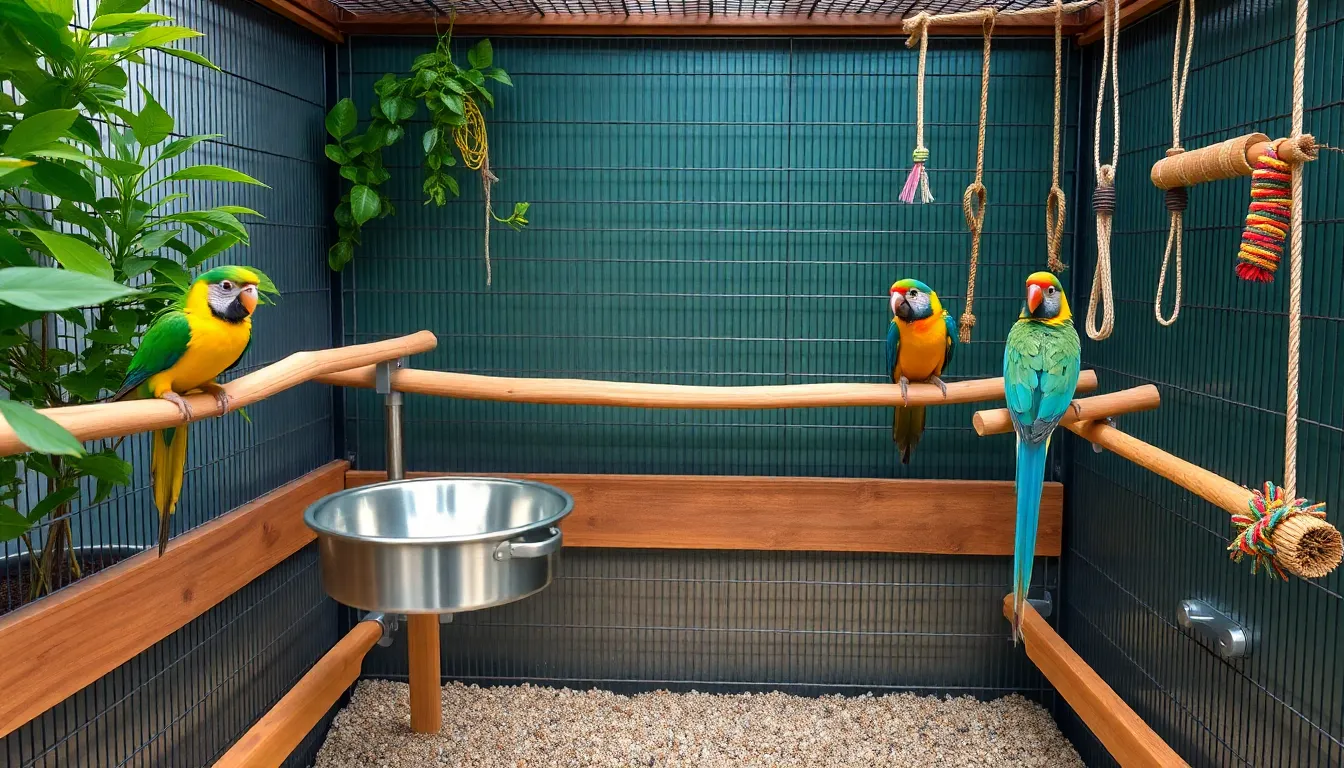
Maintaining a clean bird enclosure isn’t just about aesthetics – it’s essential for preventing disease and ensuring our feathered friends stay healthy. We’ll break down the cleaning process into manageable daily, weekly, and monthly tasks that keep your enclosure sanctuary spotless.
Daily Maintenance Tasks
Remove uneaten food from feeding areas within 2 to 4 hours to prevent bacterial growth and pest attraction. Fresh fruits and vegetables spoil quickly in warm temperatures, creating breeding grounds for harmful microorganisms that can make birds seriously ill.
Change water sources completely every 24 hours, even if the water appears clean. Birds often drop food particles, droppings, or debris into their water dishes throughout the day, contaminating what looks like pristine water.
Clean feeding bowls with hot water and bird safe soap after each meal to eliminate food residue. Stainless steel bowls require less scrubbing than plastic alternatives and resist bacterial buildup more effectively.
Spot clean droppings from perches, cage floors, and surrounding areas using paper towels or disposable wipes. Concentrated dropping areas near favorite perches need attention multiple times per day to prevent odor buildup.
Check substrate levels on cage floors and replace soiled sections immediately to maintain hygiene. Newspaper, paper towels, or specialized bird substrate materials should be changed when they become wet or heavily soiled.
Weekly Deep Cleaning Schedule
Disassemble removable components like perches, toys, and feeding accessories for thorough washing with bird safe disinfectant. Natural wood perches benefit from gentle scrubbing with a soft brush to remove accumulated bacteria and food particles.
Scrub cage bars systematically using a mixture of white vinegar and water in a 1:1 ratio. This natural solution effectively removes mineral deposits from water splashing while being completely safe for birds to contact.
Sanitize food storage areas where seeds, pellets, and treats are kept to prevent moth larvae and other pest infestations. Airtight containers should be emptied, washed, and dried completely before refilling with fresh supplies.
Wash fabric elements such as cage covers, perch covers, or soft toys in hot water without fabric softeners or harsh detergents. These items can harbor dust mites and allergens that affect bird respiratory health.
Replace substrate completely throughout the entire enclosure floor area, not just the visibly soiled sections. Fresh substrate materials provide better odor control and reduce the risk of fungal growth in humid conditions.
Monthly Safety Inspections
Examine all hardware including cage latches, hinges, and wire connections for signs of wear, rust, or loosening. Stainless steel components should show no corrosion, while painted surfaces shouldn’t display chips or flaking that birds might ingest.
Test locking mechanisms by operating each latch and door multiple times to ensure they engage properly. Double latch systems require both mechanisms to function smoothly without sticking or failing to secure completely.
Inspect electrical components such as heating elements, lighting fixtures, and misting system connections for frayed wires or water damage. Any electrical equipment showing signs of deterioration should be replaced immediately to prevent fires or electrocution.
Check structural integrity of perches, platforms, and climbing structures by applying gentle pressure to identify loose joints or cracking. Natural wood branches may develop splits or soft spots that could break under a bird’s weight.
Evaluate toy safety by examining rope toys for fraying, wooden toys for splinters, and metal toys for sharp edges or loose parts. Toys showing wear should be repaired or replaced to prevent injury from broken pieces or entanglement hazards.
Ensure Safety and Security in Your Bird Enclosure
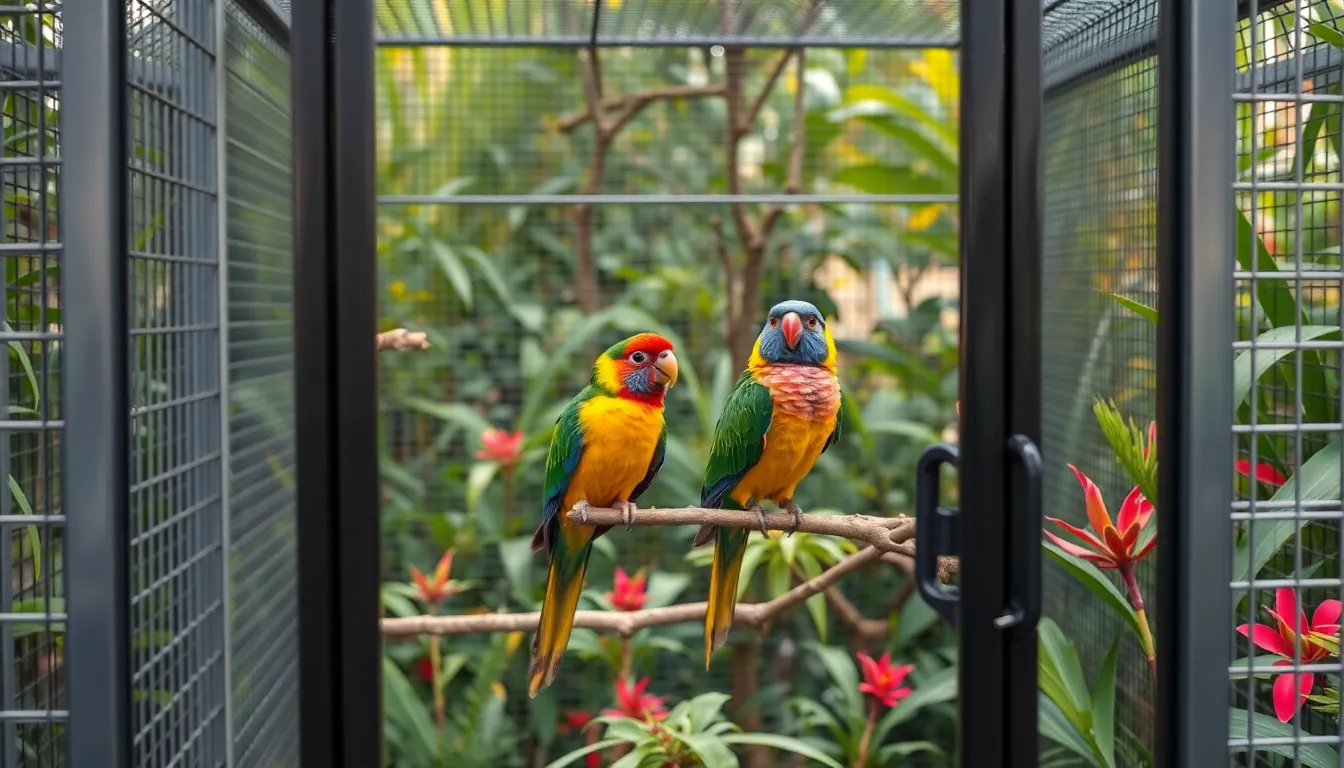
Creating a secure environment protects our feathered companions from both internal hazards and external threats. We must address potential vulnerabilities that could compromise their safety or lead to escapes.
Check for Potential Escape Routes
Inspect every joint and connection point in your bird enclosure to identify gaps larger than your bird’s head diameter. Small songbirds can squeeze through openings as narrow as 0.5 inches, while larger parrots require gaps of 1 inch or more to escape.
Examine door mechanisms and hinges for proper alignment and secure closure. Doors should close flush against the frame without leaving spaces that clever birds might exploit during feeding or cleaning times.
Test all mesh panels and wire spacing to ensure they meet safety standards for your exact bird species. Bar spacing should range from 0.5 inches for finches to 1.5 inches for large macaws, preventing head entrapment while maintaining security.
Check ceiling connections and roof panels for loose screws or warped materials that create unexpected openings. Weather exposure often causes expansion and contraction that loosens previously secure joints.
Walk the entire perimeter of outdoor enclosures to locate ground-level gaps where birds might slip underneath barriers. Bury hardware cloth 6 inches below ground level to prevent both escapes and predator entry.
Remove Hazardous Objects and Materials
Eliminate all galvanized hardware and zinc-coated materials from your bird enclosure, as these metals cause heavy metal poisoning when birds chew or ingest particles. Replace galvanized wire with stainless steel alternatives rated 304 or 316 grade.
Remove any plants from the toxic species list, including avocado plants, chocolate vine, and oleander, which pose fatal risks to birds even in small quantities. Replace dangerous vegetation with bird-safe options like spider plants, Boston ferns, or hibiscus.
Clear sharp edges and protruding hardware that could cause cuts or puncture wounds during flight or play activities. File down rough metal edges and countersink all screws flush with surfaces.
Dispose of lead-based paints and treated lumber that contain harmful chemicals like chromated copper arsenate. These materials leach toxins over time, creating chronic exposure risks for birds who explore surfaces with their beaks.
Check for small objects and loose hardware that birds might swallow, including nuts, bolts, and decorative elements smaller than a quarter. These items cause intestinal blockages requiring emergency veterinary intervention.
Install Predator-Proof Features
Add hardware cloth with 0.25-inch mesh over standard chain-link or welded wire to prevent snakes, raccoons, and other small predators from reaching through larger openings. This fine mesh creates an effective barrier without blocking airflow or visibility.
Install motion-activated lighting systems around outdoor enclosures to deter nocturnal predators like owls, cats, and raccoons. Solar-powered LED lights provide consistent illumination without increasing electricity costs.
Create double-barrier walls by installing an outer perimeter fence 3 feet away from your main enclosure. This buffer zone prevents predators from pressing against the primary barrier and reduces stress for birds inside.
Bury predator barriers 12 inches deep around ground-level enclosures to stop digging mammals like foxes and dogs. Extend hardware cloth both vertically and horizontally underground to create an L-shaped deterrent.
Add overhead protection using bird netting or solid roofing materials to shield against aerial predators such as hawks and owls. Ensure net openings measure less than 1 inch to prevent bird entanglement while maintaining predator exclusion.
Budget for Your Bird Enclosure Investment
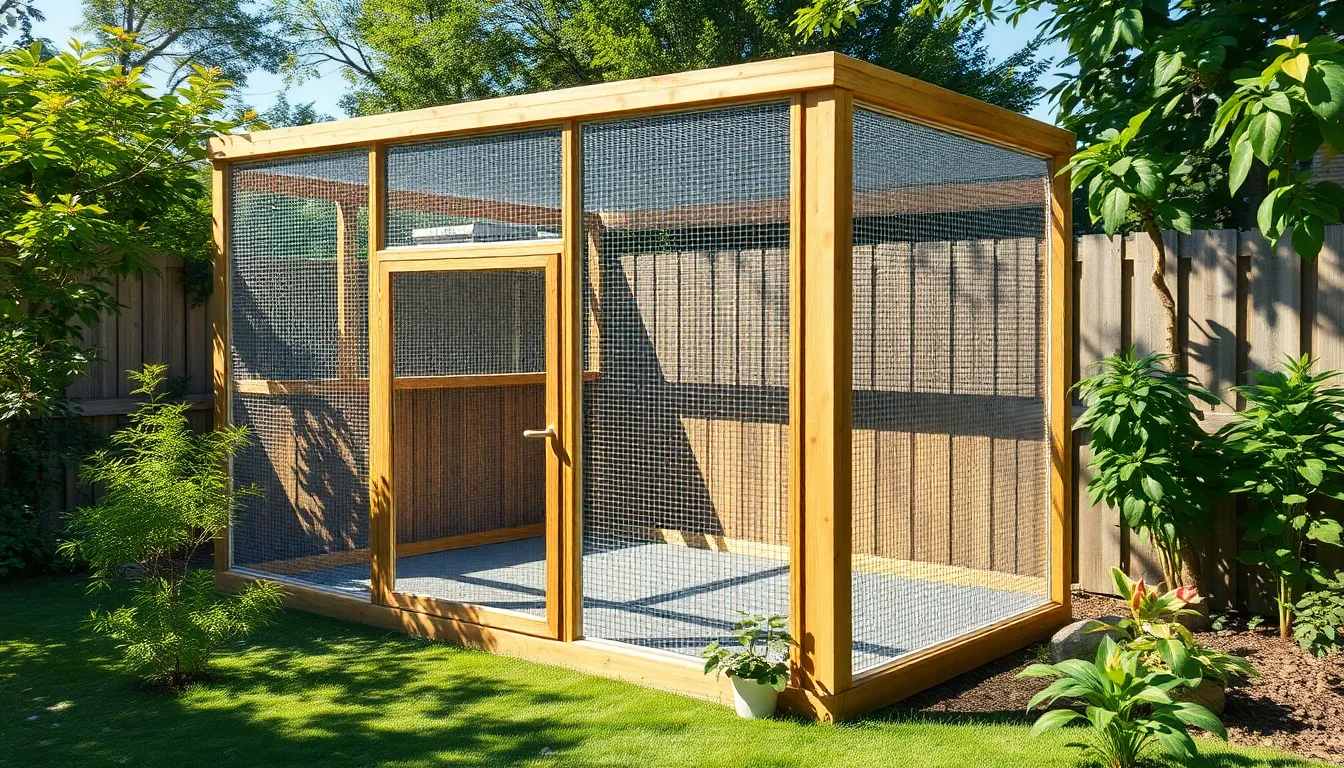
Planning our bird enclosure budget requires careful consideration of both upfront costs and long-term expenses. We’ll explore different options to help make an informed investment decision.
Compare DIY Versus Pre-Built Options
DIY bird enclosures offer important cost savings, with materials typically ranging from $200 to $800 for medium-sized outdoor aviaries. We can purchase stainless steel mesh panels, cedar framing lumber, and galvanized hardware separately to create custom dimensions. Building ourselves allows complete control over materials like marine-grade stainless steel and powder-coated aluminum frames.
Pre-built enclosures cost between $500 and $3,000 depending on size and quality specifications. Commercial manufacturers provide warranties, professional assembly instructions, and tested safety features that meet industry standards. We save time on construction but sacrifice customization options for exact bird species requirements.
Labor considerations make DIY projects require 15-30 hours of construction time for average-sized enclosures. Pre-built options arrive ready for assembly in 2-4 hours with basic tools. We must evaluate our carpentry skills against the complexity of creating secure joints and predator-proof barriers.
Factor in Long-Term Maintenance Costs
Annual maintenance expenses for bird enclosures range from $150 to $400 based on material quality and environmental conditions. Stainless steel components require minimal upkeep, while painted surfaces need refinishing every 2-3 years at $50-100 per treatment. We should budget for replacement mesh panels, which cost $30-80 per section when damaged by weather or wear.
Cleaning supplies constitute ongoing monthly expenses of $20-40 for specialized bird-safe disinfectants and replacement substrate materials. Power washing equipment rental costs $40-60 quarterly for deep cleaning sessions. We must include utility costs for heating elements and misting systems, which add $25-75 monthly to energy bills.
Hardware replacement becomes necessary every 3-5 years, with latch mechanisms costing $15-30 each and hinge assemblies ranging from $20-50 per set. Weather stripping and door seals require annual replacement at $25-40 per enclosure. We should establish a maintenance fund of $200 annually to cover unexpected repairs and component failures.
Consider Quality Versus Price Balance
Premium materials like 316-grade stainless steel cost 40-60% more than standard alternatives but provide 15-20 year lifespans versus 5-8 years for basic options. We invest $800-1,200 upfront for high-quality mesh and framing to avoid frequent replacements. Marine-grade hardware adds $100-200 to initial costs but eliminates corrosion issues in humid climates.
Budget enclosures under $400 often use galvanized steel that deteriorates within 3-5 years, requiring complete replacement. Mid-range options between $600-1,000 provide adequate durability with powder-coated finishes and standard stainless steel components. We find the best value in spending 20-30% more initially for materials that double the enclosure lifespan.
Safety features justify higher costs when protecting valuable bird collections worth hundreds or thousands of dollars. Double-latch systems cost $40-80 more than basic latches but prevent escapes that could result in bird loss. Predator-proof mesh panels cost $60-120 per section compared to $30-50 for standard options, but we protect our investment from external threats that could cause irreplaceable losses.
Conclusion
Building the perfect bird enclosure represents one of our most rewarding investments in our feathered companions’ wellbeing. We’ve covered everything from initial planning and material selection to ongoing maintenance and security considerations.
The key lies in understanding that each bird species brings unique requirements to the table. What works for a canary won’t necessarily suit a macaw and we must tailor our approach accordingly.
Remember that creating an exceptional bird habitat isn’t just about meeting basic needs—it’s about fostering an environment where our birds can express their natural behaviors and thrive. With proper planning attention to detail and commitment to quality we can create spaces that truly enhance our birds’ quality of life for years to come.
Frequently Asked Questions
What size enclosure do birds need to be comfortable?
Birds need enough space to fully extend their wings without touching the enclosure sides. Calculate minimum dimensions based on wingspan – typically 1.5 times the bird’s wingspan in width and height. For flight-capable birds, length should be at least 3 times their wingspan. Multiple birds require additional space calculations and consideration of social hierarchies to prevent overcrowding and stress.
Which materials are safest for bird enclosures?
Stainless steel (304 or 316 grade) is the safest option, offering durability and non-toxic properties. Powder-coated steel and wrought iron are acceptable alternatives, but avoid galvanized materials and lead-based paints. Marine-grade stainless steel and food-grade aluminum work well for outdoor enclosures. Always choose rust-resistant, non-toxic materials to protect your birds’ health.
How should I arrange perches and feeding areas in the enclosure?
Position perches at varying heights to mimic natural tree structures, with dominant birds preferring higher positions. Use natural wood branches for foot health and space perches to allow comfortable flight paths. Place food and water stations strategically to maintain hygiene and reduce competition. Ensure easy access for cleaning while providing designated feeding zones.
What temperature range is best for pet birds?
Most pet birds thrive in temperatures between 65°F and 78°F. Monitor temperature fluctuations with digital thermometers and install ceramic heat emitters for cold weather. Create windbreaks to reduce wind chill and establish shade zones with misting systems for hot days. Consistent temperature control is crucial for bird health and comfort.
How often should I clean my bird enclosure?
Establish a routine with daily tasks (removing uneaten food, changing water), weekly cleaning (sanitizing feeding areas, replacing substrate), and monthly deep cleaning (inspecting hardware, thorough disinfection). Regular maintenance prevents disease, ensures hygiene, and maintains a safe environment. Schedule safety inspections to check for wear and potential hazards.
What security features should bird enclosures have?
Install double-latch locking mechanisms to prevent escapes and unauthorized access. Use fine mesh screens appropriate for your bird species size to prevent squeezing through gaps. Install predator-proof features like motion-activated lighting and secure barriers. Regularly inspect all joints, door mechanisms, and hardware to ensure continued security and safety.
Should I build or buy a pre-made bird enclosure?
DIY enclosures save money but require significant time, skills, and tool investment. Pre-built options offer convenience and professional construction but may lack customization and cost more upfront. Consider your budget, timeline, and specific bird needs. Quality materials are essential regardless of choice, as they ensure durability and long-term safety.

